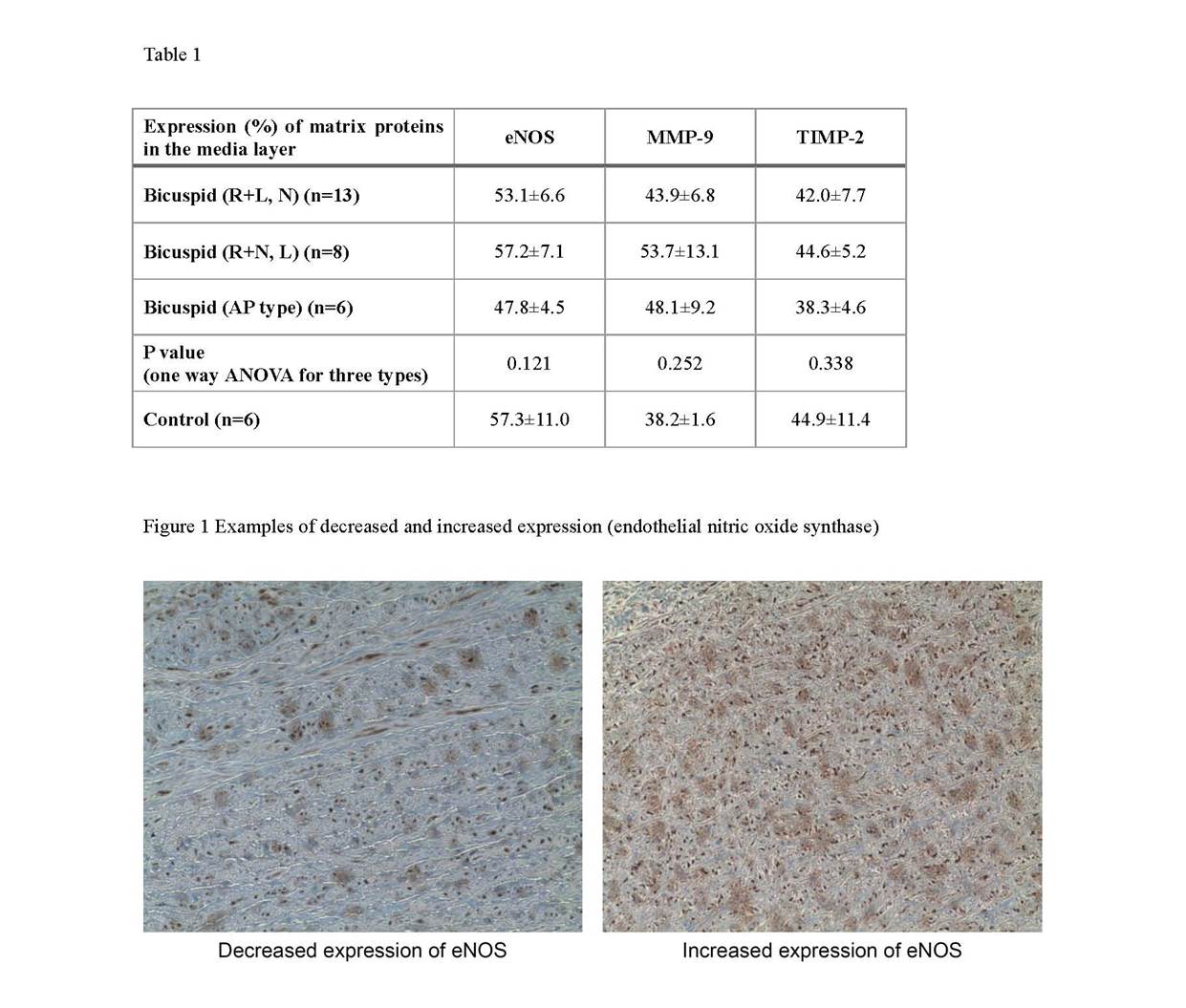초록접수 현황
| 14F-009 | 구연 발표 |
Clinical Implication of Aortic Wall Biopsy in Aortic Valve Disease
with Possible Bicuspid Valve Pathology
김경환¹, 김용한¹, 장형우¹, 김준성²
서울대학교 의과대학 서울대학교병원 흉부외과학교실¹, 분당서울대학교병원 흉부외과학교실²
Background : There have been reports about unique aortic pathology related to bicuspid aortic valve. However, the clinical implication of bicuspid aortic valve pertaining to the risk of aortic disease is yet to be investigated. Considering various types of bicuspid aortic valves, we sought for potential difference in matrix protein expression in the aortic wall according to varying types of bicuspid aortic valves.
Methods : We obtained 3×3 mm sized aortic wall specimens from 33 patients; bicuspid aortic stenosis group (n=27), tricuspid control group (n=6). Mean patient age was 68±10 years, and 22 patients (66%) were male. Patients were categorized into four groups; tricuspid group (n=6, 18%), R+L group (n=13, 39%), R+N group (n=8, 24%), and anteroposterior (AP) group (n=6, 18%). The specimens were analyzed with immunohistochemistry (IHC) for the expression of endothelial nitric oxide synthase (eNOS), matrix metalloproteinase (MMP) -9, and tissue inhibitor of matrix metalloproteinase (TIMP) -2 in the media layer. Microscopic images were quantitatively measured with image analysis software. The results of IHC analysis were compared with gross morphology of aortic valve.
Results : Between bicuspid group (n=27) and control group (n=6), there was higher tendency for aortopathy (expression of eNOS, MMP-9) in bicuspid group without statistical significance; eNOS (bicuspid:control)=53±7%:57±11%, MMP-9 (bicuspid:control)=48±10%:38±1%. Between fusion group (R+L and R+N, n=21) and AP group, expression of eNOS showed a trend that AP group has lower values; 54±7% vs 48±5% (P=0.08) (Figure 1). In contrast, types of bicuspid valve (R+L, R+N, and AP) did not result in significant difference in the expression of eNOS, MMP-9, and TIMP-2 (Table 1).
Conclusion : From human aortic specimen, the evidence of bicuspid-related aortopathy was unclear in our study. However, we could find the trend in decreased expression of eNOS in the aortic wall of patients with bicuspid aortic valves, especially in AP relationship morphology. The severity and risk of aortic disease could be re-evaluated with types of bicuspid valve. However, at least, from our data, bicuspid aortic valve might not be a significant indicator of aortopathy than tricuspid valve.
Methods : We obtained 3×3 mm sized aortic wall specimens from 33 patients; bicuspid aortic stenosis group (n=27), tricuspid control group (n=6). Mean patient age was 68±10 years, and 22 patients (66%) were male. Patients were categorized into four groups; tricuspid group (n=6, 18%), R+L group (n=13, 39%), R+N group (n=8, 24%), and anteroposterior (AP) group (n=6, 18%). The specimens were analyzed with immunohistochemistry (IHC) for the expression of endothelial nitric oxide synthase (eNOS), matrix metalloproteinase (MMP) -9, and tissue inhibitor of matrix metalloproteinase (TIMP) -2 in the media layer. Microscopic images were quantitatively measured with image analysis software. The results of IHC analysis were compared with gross morphology of aortic valve.
Results : Between bicuspid group (n=27) and control group (n=6), there was higher tendency for aortopathy (expression of eNOS, MMP-9) in bicuspid group without statistical significance; eNOS (bicuspid:control)=53±7%:57±11%, MMP-9 (bicuspid:control)=48±10%:38±1%. Between fusion group (R+L and R+N, n=21) and AP group, expression of eNOS showed a trend that AP group has lower values; 54±7% vs 48±5% (P=0.08) (Figure 1). In contrast, types of bicuspid valve (R+L, R+N, and AP) did not result in significant difference in the expression of eNOS, MMP-9, and TIMP-2 (Table 1).
Conclusion : From human aortic specimen, the evidence of bicuspid-related aortopathy was unclear in our study. However, we could find the trend in decreased expression of eNOS in the aortic wall of patients with bicuspid aortic valves, especially in AP relationship morphology. The severity and risk of aortic disease could be re-evaluated with types of bicuspid valve. However, at least, from our data, bicuspid aortic valve might not be a significant indicator of aortopathy than tricuspid valve.

책임저자: 김경환
서울대학교 의과대학 서울대학교병원 흉부외과학교실
연락처 : 김경환, Tel: 02-2072-3971 , E-mail : kkh726@snu.ac.kr




















